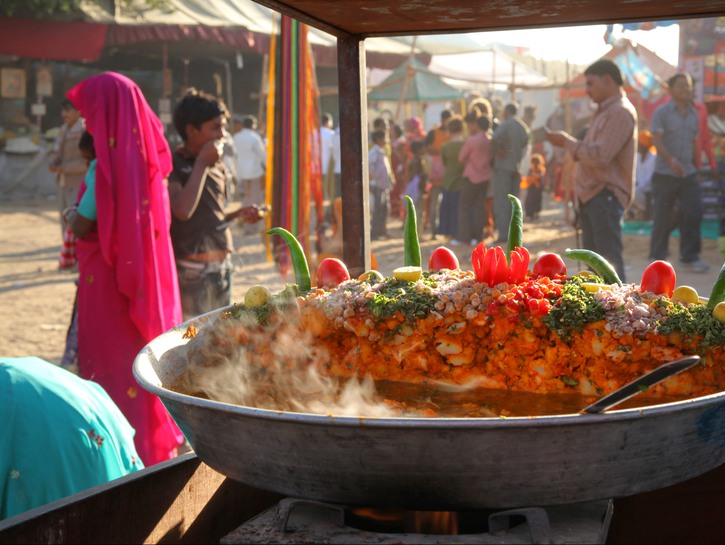
The aroma of curries cooking is intoxicating, and eating Indian food where it originated and has been evolving for centuries is the treat of a lifetime. In Indian kitchens, bubbling pots sit next to bowls of freshly chopped herbs and vegetables; sidewalk farmers markets overflow with baskets of coriander leaves, turmeric and ginger roots, and red carrots and onions, all competing for your attention.
Videos by TravelAwaits
If lucky, you’ll watch a meal unfold in a home kitchen, guest house, or village compound. Guided food tours can take you behind the scenes and into the best local places to eat. They’re a sound way to start exploring Indian food and can help you avoid Delhi Belly, the Indian equivalent of Montezuma’s revenge — that is, digestive havoc that no traveler wants to endure.
General Advice
Be cautious about eating new foods, but don’t limit yourself to “Western” options. It’s a good strategy to start slowly as you adjust to the world of Indian cuisine. If your first introduction to Indian food is at your hotel’s breakfast buffet, resist filling up on the tried-and-true offerings. Look to the fresh breads; roti stuffed with mild cheese, chapatis, naan, and puffy bhatoora are usually safe choices as long as you don’t have gluten issues. Explore further with idli, ovals of steamed rice served with coconut and green chutneys — or buttery dosas, papery crepes made with fermented rice and lentils.
Get Your Gut Ready Before Leaving Home
Indian food is delicious and you may be tempted to eat it all, but consider what you eat at home and what makes your stomach happy. If you tend to avoid jalapeno peppers and hot sauce because they lead to poor sleep or an inflamed gut, then eating thick chili paste and dishes full of sliced peppers will compromise your comfort in India, too.

Elaine J. Masters
If you’ve taken antibiotics recently, your doctor may have suggested that you replenish your intestinal flora with probiotics after completing your prescription. There are a host of probiotic-rich foods like kombucha, yogurt, and other cultured milk products like cottage cheese that can aid digestion. Consider priming your gut with probiotics and bringing easy-to-pack probiotic tablets or powder packs with you. These can help your gut manage the stress of travel and new cuisines.
Manage Your Digestion Issues Regionally
Indian food is renowned for its spice and complexities. Each region in the vast subcontinent offers traditional dishes and seasonal treats. If you are planning your travel according to a bucket list of dishes you want to eat, consult Indiamarks’ list of Indian food by region.
In the megalopolis of New Delhi, you’ll find international foods and dishes from all over India. Savory dishes are full of coriander and potatoes, and you’ll also encounter complex stews and roasted meats. In the Jaisalmer region near the Thar desert, you’ll find dishes influenced by the region’s proximity to Pakistan. Throughout India, many dishes are meatless and dairy free.
Make Cultured Milk Drinks Your New Travel Buddy
Walk the streets of Jaipur and you’ll pass Indian food carts and small alcoves where lassi vendors pour the slightly sweetened, clotted drink into unglazed clay cups. Kulhars, originally from North India and Pakistan, are handleless clay cups that are typically unpainted and unglazed. As one of India’s alternatives to plastic cups, they’re recyclable — a single-use item that supports a cottage industry. The lassi within is a shortcut to a healthy gut. For pennies you can sip on a rich source of protein and local probiotics.

Whether consuming it in lassi, yogurt, or another treat, the bacteria in local milk from revered cows will supplement your intestinal flora and help to acclimate your digestion to the new foods you’ll want to eat throughout the country. It’s a rich and easy supplement that many believe is the best way to adjust to India’s cuisine. At different times of the year, lassi’s available in different flavors — mango in the summer and nutty cardamom or even cannabis throughout the year.
Another gut-friendly choice is chaas, a savory, fermented buttermilk drink often flavored with salt and pepper and sometimes garnished with chopped coriander leaves. You may even find it served alongside your meal. Both drinks coat your digestive track with vitamins, calcium, and beneficial acids.
Note that even if you’re lactose intolerant, full-fat yogurt may still be digestible if it has live and active bacteria. Know before you go and once in India, try a little and monitor your gut’s reaction.
Drink Water Often (And Only Filtered)
Staying hydrated is a must for overall health, plus it keeps your digestive tract moving — both of which are essential to making the most of a trip. In India, staying hydrated means drinking only safely filtered water. Consider carrying a reusable filter bottle like the Lifestraw system, which features an encased filter. Ensure that any bottled water you plan to drink is sealed firmly before you open it. Avoid ice cubes unless you’re confident of their source, and use filtered water to brush your teeth and when rinsing and cleaning your brush.

Elaine J. Masters
Dive into rich dishes and stews knowing that well-cooked food is safest. You’ll rarely find beef on the menu, but chicken curries, skewers, and tandoori-grilled options are abundant. Make sure proteins are cooked through by cutting into a piece before you start eating. Consider sharing entrees with your travel buddies instead of over-eating a big meal at night, which can compromise your sleep as your tummy kicks into digestion mode.
Go Local And Take Chai Breaks
Chai means tea in Hindi and some other Indian languages, and this popular drink is made with black tea, ground pepper, and lots of ginger boiled together with milk. The boiling helps infuse the rich flavors into the beverage and usually makes it safe to drink. Whether made with ground or fresh ginger, the inclusion of the spice is delicious and helps facilitate digestion. It’s usually served in small cups and is slightly sweetened.
Assess Your Risk And Treat Your Symptoms
Foodborne illness occurs around the world, and Indian food is often seen as a culprit. Delhi Belly may start simply from poor hygiene during preparation, lax storage, absent refrigeration, or old ingredients, all of which can lead to the introduction of flora that’s disruptive to your digestion. Stomach problems from food poisoning or diarrhea can start slowly or emerge explosively. There are medications both over the counter and prescribed to treat the symptoms, but most important is staying hydrated.
The symptoms may be mild to severe, but most don’t require hospitalization. Certain antibiotics may help and being prepared with a prescription of Cipro or Azithromycin is wise. Bring Imodium for diarrhea. Pepto Bismol tablets are easy to carry and some travelers swear that taking them proactively helps to avoid problems from eating Indian food. Bring a lot! When your travel buddies know you have them, they’ll want to share.
Strategies For A Happy Tummy
Whatever you’re eating, be sure to wash your hands and carry tissues for the toilet — and be prepared for bathroom experiences that necessitate planning ahead. When exploring street foods, look for popular vendors. If you see mothers and children eating from a stall, there’s a good bet the food is safe. Drink bottled sodas and enjoy Kingfisher beer when available. Avoid unpeeled fruit and uncooked vegetables.

Elaine J. Masters
If you do develop Delhi Belly, be sure to stay hydrated. Diarrhea won’t kill you, but being dehydrated could. If you can’t keep enough water down, you may need to go to a hospital for intravenous assistance. Note that most savvy travelers carry Imodium. Take the capsules according to directions and consider using a full round of antibiotics should your symptoms linger. Let your travel buddies know what you’re going through and have them check on you.
Visiting India can be the trip of a lifetime. Take care of yourself so the memories of all the wonderful food you consume will be happy ones!
Photo Credit: Ksenija Toyechkina / Shutterstock, ImagesofIndia / Shutterstock
